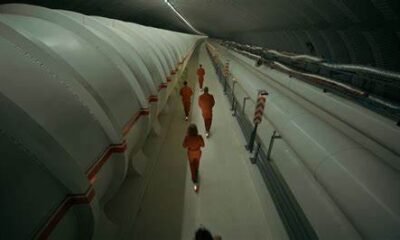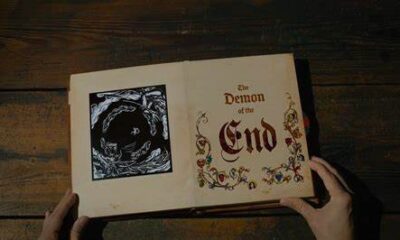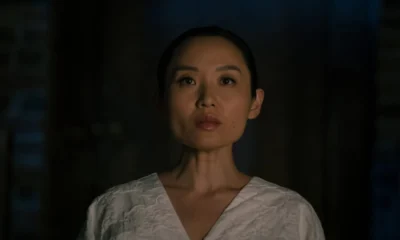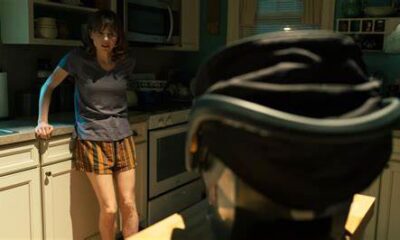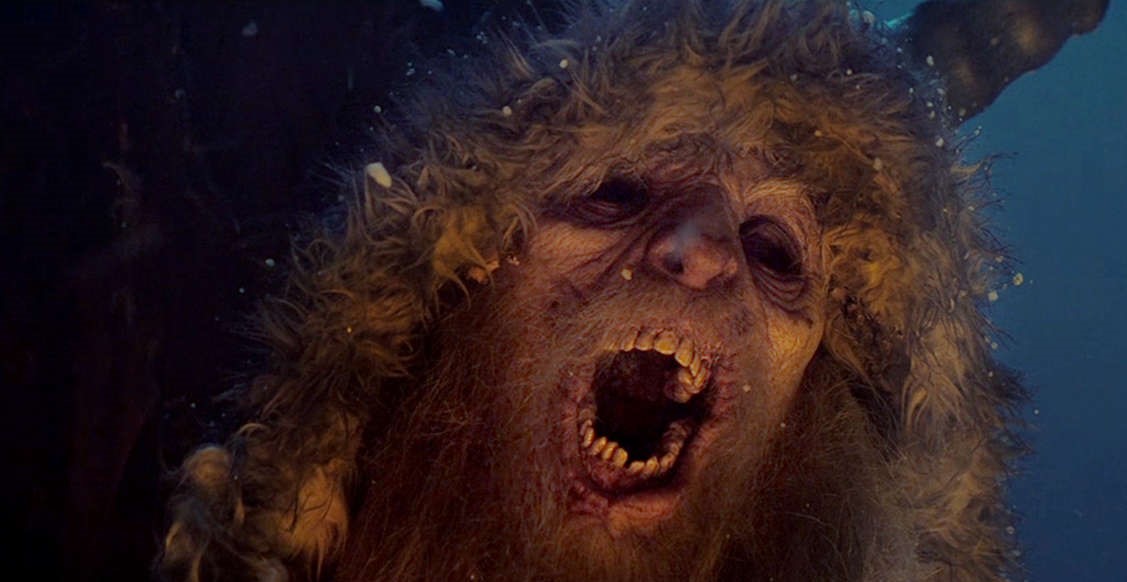
Krampus (2015) Review
‘Krampus’ is available for purchase on all VOD platforms as well as physical Blu-Ray/DVD. For the best viewing experience, be sure to purchase Scream Factory’s latest 4K UHD upgrade, Krampus: The Naughty Cut; the perfect gift for the Krampus fanatics in your lives.
In 2015, writer/director Michael Doughtery (Godzilla: King of the Monsters) released his Yuletide horror film ‘Krampus’ to the masses. Receiving mostly positive reviews upon its release, this tale became an instant modern holiday horror classic amongst fans and myself. Riding the success of his previous holiday horror film Trick R’ Treat, the violence and gore for Krampus is tamer but the fright and silliness from his previous entry is still very present here. Presenting awe-inspiring visuals, impeccable creature designs, an enjoyable cast of characters, and Doughtery’s signature dark humor, it’s surprising we’ve yet to receive a sequel. With the holidays fast approaching and the bitter chill of winter coursing through the air, what better time to revisit this Christmas masterpiece?
Retail Killed the Christmas Star….
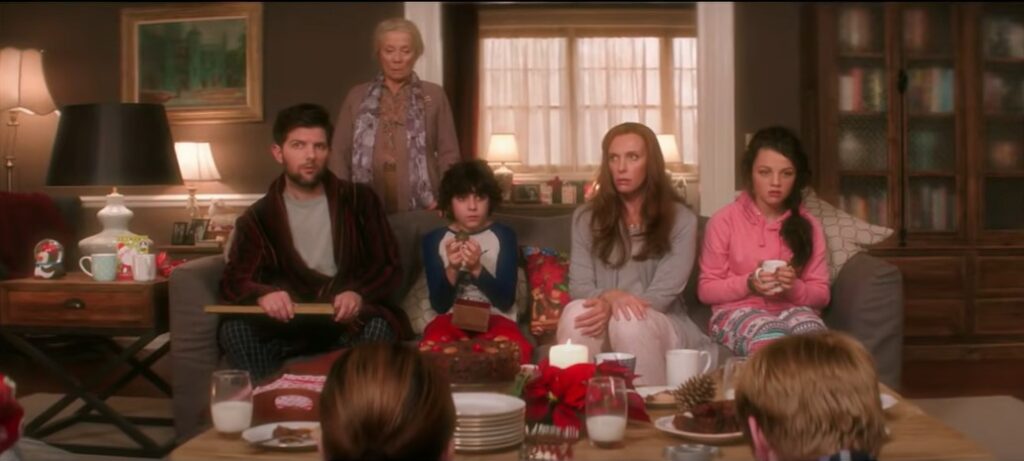
While most children’s letters to Santa consist of the a-typical toys and the latest tech and fashion trends; our protagonist Max (Emjay Anthony) has a more selfless request to share a nostalgic Christmas with his family reminiscent of years past. Shortly after his Uncle Howard (David Koechner from ‘Anchorman‘), Aunt Linda (Allison Tolman), their infant Crissy (Sage Hunefeld) and remaining children Howard Jr. (Maverick Flack), sisters Jordan (Queenie Samuel) and Stevie (LoLo Owen) and Great Aunt Dorothy (late Conchata Ferrell remembered famously as Berta in CBS’ ‘Two and a Half Men‘) arrive after a long day’s travel, tensions soon ensue. Dorothy is constantly complaining on the quality of the food even though Max’s mother Sarah (lovingly portrayed by academy award nominee Toni Collette; ‘Hereditary‘ and ‘Velvet Buzzsaw’) had been slaving away all day in the kitchen prior to their arrival. Howard almost immediately begins showboating his superiority complex and toxic masculinity to Max’s father Tom (played by Adam Scott of ‘Parks and Recreation’ fame) from the moment he walks in the house. Additionally, Jordan and Stevie purposefully embarrass Max at dinner by reciting his private letter to Santa in front of everyone. This sparks an emotional scuffle amongst the kids, and in a fit of rage Max shreds his only wish and tosses the remaining bits of the torn letter out of his bedroom window. Unfortunately for Max and his family, these actions summon not jolly Saint Nicolas but rather, a more sinister shadow and counterpart to the big man dressed in red. In order for Max and his family to survive this unholy night of terror, it’s imperative they set aside their differences and come together, otherwise their souls will be dragged to hell, suffering eternal damnation.
Visually, ‘Krampus’ is beautifully shot as Doughtery is able to capture the chaotic nature that falls on Christmas, but also, the magic bestowed upon it. The production design is flawless as festive decorations fill the screen with their blinking-colored lights, Christmas music blares from radio speakers, and pristine mounds of glistening snow cover the streets. Doughtery also takes lengths to showcase the insanity of holiday shopping in the films chaotic title sequence. Max and his family are clad in winter clothing, showing their slight enthusiasm for the approaching holiday. In grandiose fashion, Krampus christens his arrival into town with an unnatural blizzard, plaguing them in a dreary winter wonderland. You feel the intensity of the cold as our characters struggle bundling for warmth.
Santa Claus ISN’T coming to town
Draped in large red and white robes akin to Saint Nicolas, large, pointed horns curling above his head, the clattering of his massive cloven black hooves booming on rooftops, his face adorned with a mockery of the children’s beloved holiday figure; Krampus has arrived. Time has certainly been kind to Krampus, as 7 years later the character design is still remarkable. Standing close to 7 feet tall, his presence is especially imposing due to his hulking size and rough exterior. For as colossal as Krampus is, it still surprises me just how agile his character is able to swiftly move about. His laugh echoes in twisted delight as his grotesque tongue whips about, echoing his unapologetic personality; for he is there to punish. Whenever on screen, he steals the show as his presence is awe-striking.
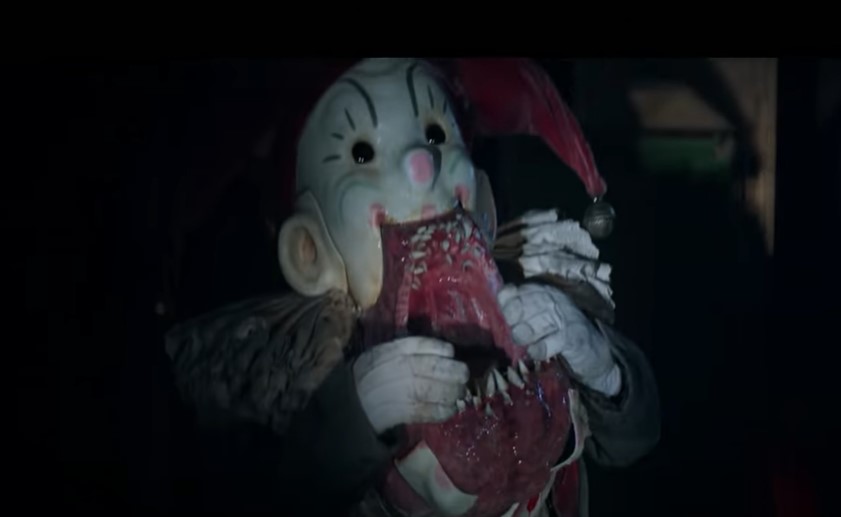
Thankfully, Krampus isn’t the only character with a fearsome appearance, as his evil elves and twisted animated toys receive ample care equivalent to their master. Drawing inspiration from pagan/folkloric background, these maniacal elves first appear disguised as snowmen mysteriously appearing in Max’s front yard Christmas Eve morning, inching closer to the house ever so slightly with each passing hour. Once their surprise attack springs into action, we see them fully cloaked in dark soot-stained furs with intricately detailed wooden masks and carrying makeshift tribal spears. Whereas Santa’s elves are merry helpers, Krampus’ are anything but, acting more as slaves. His “cheerful” toys are no exception. Consisting of ravaging teddy bears, ghastly noel angles, and buzzsaw wielding robots, each toy feels craftly designed, providing their own unique flare and deadly purpose. One toy that’s remained a favorite of mine in particular happens to be their unofficial mascot and Krampus’ own twisted transport; his hideously cute jack-in-the box. Masquerading first as an innocent child’s toy only to later reveal its gaping mouth and rows of gnashing teeth capable of swallowing multiple victims whole.
‘Krampus’ lasting success can also be attributed to the characters Doughtery brings with his script, as well as the brilliant performances provided by each actor. Krista Stadler is wonderful as Omi, Max’s softhearted grandmother who’s experienced this holiday demon in her past. Scott and Collette’s’ Tom and Sarah exemplify what nurturing parents should be; comforting Max during times of weakness, while acting as the families selflessly fierce protectors. Emjay, however, really shines in this movie with his portrayal of Max. He’s able to convey the emotional stresses we see Max struggles with throughout. At first, Max seems hopeful this will be different than his past few have been. As the night unfolds, that hope quickly fades and shifts to anger. Anger then transcends to fear then guilt for the curse he’s mistakenly brought upon his family up until the final act in which Max finally confronts his demon head-on, accepting responsibility with fearless fervor.
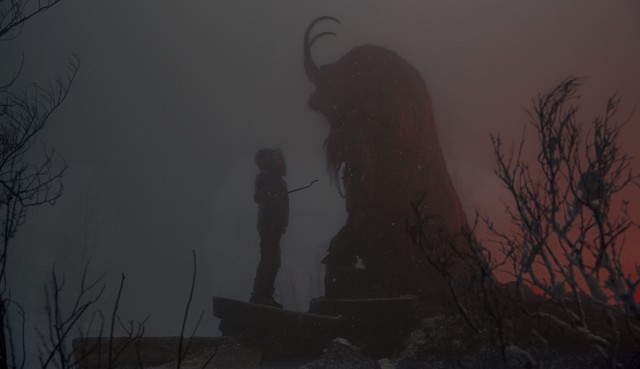
Checked Twice: The Naughty List
‘Krampus’ succeeds in many areas; however, it has its mild issues. For as much as I appreciate Doughtery’s dark humor, there are times where I feel it’s overused in this script taking away from the horror. In a scene paying homage to 1984’s ‘Gremlins‘, rather than fiendish green creatures, we instead see poorly animated CGI gingerbread men that are more of an annoying nuisance than actual threats. This is especially disappointing given the films primary use of practical effects. Koechner’s Uncle Howard and Ferrell’s Aunt Dorothy, though equally hilarious and provide a hand in protecting the family, ultimately feel as the film’s comedic reliefs to me. Max’s sister Beth (Stefania LaVie Owen) feels as though she was only included to fill the role of disinterested snotty sister. Not to say actress Stefania’s performance is bad, it’s not, her character is simply under used which provides lack of development. Those expecting to unwrap a carnage candy cane for the holiday season may be disappointed due to the films more family-friendly PG-13 rating. With his use of meticulous camera placement and expertise with lighting and shadows, Doughtery trades in the gore for jump scares through tension building.
A Beloved Demon of Christmas Past
Throughout the years since its release, ‘Krampus’ has been in my yearly Christmas film rotation for obvious reasons; relatable characters, time lasting practical effects, enthralling cinematography and an impactful surprise twist. At first glance, it may appear as if Doughtery has a disdain for Christmas but, with each revisit, it’s made clearer the respect he has for the holiday. Though a fun chaotic sleigh ride filled with horrific creatures, Krampus is a story told with love reminding its audience the true spirit of Christmas is not the lavish gifts but showing our loved ones the same care and cherishment. Doughtery further establishes his mastery of comedic horror with ‘Krampus‘, providing plenty of sacks of laughs and scary presents worthy of being a yearly tradition for any family.

Be sure to check HauntedMTL all month long for more holiday horror related content, including our ’12 Nightmares of Christmas’. 12 spine-tingling holiday themed short horror stories written by us, including yours truly, dropping every day starting December 12th, leading to Christmas day.
 (4 / 5)
(4 / 5)
Movies n TV
Wheel of Time A Question of Crimson Is a Political Espionage Delight
Episode two of Wheel of Time felt like the beginning of a long journey. Stories are unfolding, lives are changing, and blood is spilling.
Let’s discuss.
The story
We begin this episode in the past with Elayne’s mother, Queen Morgase. It turns out her rise to the throne was a bit, shall we say, cutthroat. So when she shows up at the White Tower, Siuan is concerned.
She might have reason to be, too.
Meanwhile, Rand, Egwene, Moiraine, Lan and Aviendha are in the Spine of The World. As they travel through some of the most breathtaking lands I have ever seen on a TV show, Egwene is plagued with nightmares. We think at first that’s just her trauma working itself through her system. But we soon find out that it might not be that straightforward.
Finally, Perrin returns home to heal after his hand is almost cut in half. But when he gets there he finds the town has been infested by Children of The Light. And they’re looking for him.
What worked
There was something heartwarming in this episode about political espionage and choking religious persecution. And that is Elayne’s relationship with her family.
I have consumed a lot of fantasy content with royal families. And I have never once heard a princess call her mother ‘Mum’. I’ve never seen royal siblings get along. And I have sure as hell never seen a princess have a good relationship with her step-parent.
This was refreshing. Even though Queen Morgase is kind of a horrible person she seems like a good mother. And that’s an unexpected delight.

Of course, this is just one storyline among many. And while this can sometimes be overwhelming, in this case it wasn’t.
I’ll be honest, some of these storylines are going to drag for me. I know this because I’ve read some of the Wheel of Time books and I have an idea that not all the characters exactly pique my interest.
No one likes all the characters. No one likes all the storylines. While I am here for the political espionage between Queen Morgase and Siuan, not everyone likes it. While others might be fascinated with Selene trying to win Rand back, I couldn’t care less.
Having multiple storylines keeps everyone’s attention better. So long as things don’t get out of hand. Things can easily get out of hand. But this seems to be managed well.
So far.
What didn’t work
As I mentioned above, I’m not thrilled with Rand’s story at this point. And while it’s fine to not like a storyline when there are this many to choose from, it’s not fantastic that the one I like the least is the one involving our two main characters. And anytime we were with the team at the Spine of The World, the only thing that brought me joy was Moirain’s hat. It reminded me of Stockard Channing’s hat in Practical Magic.
The problem is that Rand is Charlie Brown with controversial magical powers. He is boring, serious, and pessimistic.
And yes, I understand that he has a heavy emotional burden and he’s the Dragon Reborn and that’s quite taxing and all. But let’s be fair, there isn’t a single person in this show that doesn’t have a heavy burden. And most of them manage to be fun occasionally.

All that being said, this episode of Wheel of Time did exactly what it needed to do. It set up conflicts at each of the three locations. It established emotional ties between the characters and the events. And it established goals for everyone.
This was, in short, a solid episode. Not groundbreaking, not mind-blowing or life changing. It was simply good. It was entertaining and moved the plot forward.
Well done.
 (3.5 / 5)
(3.5 / 5)
Movies n TV
Wheel of Time Returns With A Bang
Wheel of Time is back for season three. There are mixed feelings regarding this. Last season, there were some serious pacing issues. And some serious sticking to the book’s storyline issues. But we’re two seasons in, and we don’t give up so easily. So let’s dive into episode one, To Race the Shadow.
By the way, I highly recommend watching this episode with the subtitles on. You’ll see why.
The story
We begin this episode with Liandrin facing a trial of sorts for her rampant betrayal. She does her best to gaslight her Aes Sedai sisters into thinking that Siuan Sanche is the real traitor.

When that doesn’t work, she reveals how many Black Aes Sedai have actually infiltrated the tower.
Spoiler, it’s a lot.
In the aftermath, our whole team gathers to drink and enjoy one night of relaxation before they head out to the Tear to form an army for Rand. All is going well until they’re attacked by myriad creatures and a sentient axe.
What worked
This episode was long. It had a run time of an hour and eleven minutes. And a lot of that run time was spent in heavy dialog scenes.
Fortunately, these were well-done scenes.
If you’re going to have a lot of talking scenes, there are good ways and bad ways to do it. Last season, we saw lots of examples of the bad way to do it. But this episode did it well. For one thing, other things were going on while conversations were taking place. The characters are drinking, playing games, walking through an interesting city. And the scenes themselves didn’t stretch out. They weren’t repetitive. We heard what the character had to say, then we moved on.
It was also nice that the point of these scenes wasn’t just info dumps. We had character development. We had romantic interactions. We had plot development and foreshadowing.
Overall, this episode felt like what it was. A moment of calm before a storm.
Taking a step back, I’d be remiss if I didn’t address the fight scene at the start of the episode. Because it was epic.
The magic looked amazing. The martial arts that went along with it looked fantastic. The costumes were beautiful. It was just incredibly fun to watch.
More than that, it was emotional. We lost some characters in that fight that were important. And it was clearly emotionally shattering for many of our characters, who found themselves betrayed by people they trusted.
So many of them.
It was a great way to open the season.
What didn’t work
Despite that, this episode wasn’t without its flaws.
First off, there were a lot of dialog scenes. And they were good scenes, as I’ve already discussed. But it was one after another after another. And when your episode is, again, an hour and eleven minutes, it’s maybe a little much to have so much chit-chat. Couldn’t some of these conversations, important as they were, have been moved to maybe another episode?
Finally, I want to talk about Egwene’s travel through the arches.

I feel like maybe there were some deleted scenes here. Because there must have been more to that visit than what we saw, right?
We could have seen Egwene battle Rand. That would have been badass and emotionally devastating. We could have seen her with a quiet life with Rand back home at the Two Rivers. We could have seen anything except for the quick clip of Rand in a bloody river, followed by Egwene being shoved back out in a bloody shift.
Bad job. But at least it wasn’t an extended scene of Moiraine collecting bathwater, and then taking a bath while looking sad. If we’d started this season with another scene like that, it might have broken my brain.
Amazon dropped the first three episodes at once. So we’ll be back soon to talk about episode two. See you then.
 (4 / 5)
(4 / 5)
Movies n TV
Entertaining as hell: Eight Legged Freaks (2002) Review
Early 2000s is a special era for the industry. It accepts the cheesiness and corniness of movie making, in turn producing some gems in their own right. Eight Legged Freaks starring David Arquette and young Scarlet Johanson is a horror comedy about giant spiders who overtake a small town. As crazy as that premise sounds, the movie surprisingly has a ton of heart and is super entertaining. Let’s review, shall we?
Plot
We start Eight Legged Freaks with a shot of toxic waste spilling into the water supply of Joshua, a spider farm owner. He is friends with Mike, one of our protagonists, who is a science geek and a spider enthusiast. Mike notices something quite right upon visiting Joshua, but no one takes him seriously. We are then introduced to the rest of the crew. Mike’s mother Samantha, the town sheriff, is too busy chasing Ashley, his sister, who is dating the town mayor’s son Bret (something Samantha does not approve of). We also have Chris, who returns to the town to save his father’s legacy in the town mines. He has opposition from Wade, Bret’s father, who wants to use the mines for his business ventures. Lots of drama going on that will only get juicier once the spiders get loose.
The creepy crawlies quickly dispose of Joshua and make their grand appearance after Ashley rejects Bret’s advances, abandoning him in the middle of a desert. A glorious chase sequence ensues as the spiders make their way towards the town, wreaking havoc on its residents. In a true horror fashion (which the movie acknowledges), it takes some convincing from Mike and then from Samantha for the town to take the threat seriously. The tongue-in-cheek style of narrative adds the comedy aspect to a movie that would otherwise burn out fairly quickly.
The remaining characters hide out in a shopping mall as it’s the only somewhat sturdy building in the area. This doesn’t last long as the spiders break in, forcing them to run through the mines. Their resources to fight the creepy crawlies off are limited as the methane gas doesn’t allow them to use firearms. Such conditions require resourceful thinking from Chris, who uses perfume to fend off the leader of the spider group and save himself during the climax of the movie.
Character dynamics are not forgotten once the action kicks in. We have Chris confessing his long-term feelings for Samantha which she knew all along, which provided some comedic relief. Bret also reunites with Ashley and apologises for being an asshole. Mike finally gets the appreciation he deserves as his knowledge saves the townsfolk more than once during the whole ordeal.
We end the movie with the town’s radio show person telling the story as an urban legend during his segment. This brings it into question – how much of it happened the way he said it did? We can only guess…
Overall thoughts
Eight Legged Freaks is a fun creature feature with some self-aware commentary on genre tropes that doesn’t take itself too seriously. The acting is good, the pacing fitting and the characters are likeable enough for you to want them to make it through. Definitely a must watch, if you don’t suffer from arachnophobia, that is.
 (5 / 5)
(5 / 5)


